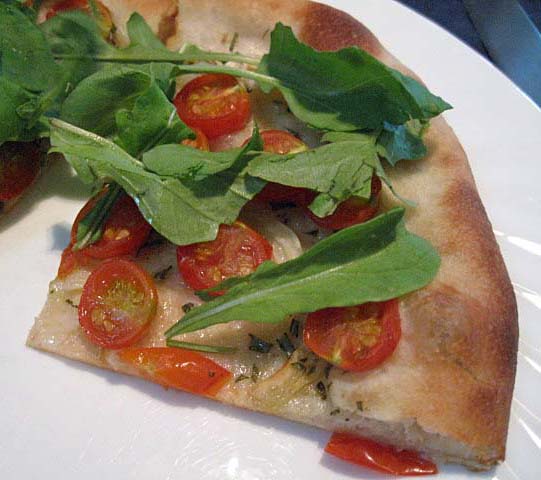
You can go nuts trying to find the perfect pizza dough formula. The cookbooks and the web are full of recipes for various types of dough and full of opinions regarding the type of flour to use, the ingredients (beyond flour, water, salt and yeast) and the mixing and fermentation methods that work best.
My goal for today was what I understand to be classic pizza napoletana. The dough should consist of the four basic ingredients only – no oil, sugar, malt or other stuff. The crust should be very thin and crisp on the bottom, not soft or soggy. The toppings should be minimal, so the crust is the main attraction.
After reading through many, many recipes, I settled on the one in Maggie Glezer's “Artisan Breads.” It uses the 4 ingredients only. It is for a Naples-style pizza. It is credited to Emanuele Leonforte of Hosteria restaurant in Port Chester, New York.
Leonforte uses a mix of Doppio Zero and high-gluten flour that Glezer calculates as resulting in about 12.5% protein. He uses a remarkably short mix. He ferments the dough for a long time but only once. Glezer gives the option of retarding the dough overnight and fermenting it the next day, and that fit best with my schedule. The method I used is described below.
Ingredients | Wt. | Baker's % |
KAF Bread Flour | 500 g | 100 |
Instant yeast | 1/4 tsp | 0.2 |
Salt | 10 g | 2 |
Water, lukewarm | 330 | 66 |
Method
Measure the flour, yeast and salt into the bowl of a stand mixer and mix them.
With the dough hook in place and the mixer at slow speed, gradually pour in the water.
Mix until the dough forms a ball and cleans the side of the bowl, about 3 minutes.
Cover the bowl and let the dough rest for 10-15 minutes.
Mix the dough at Speed 2 for about 3 minutes. It should be fairly smooth but will not pass the window pane test.
Transfer the dough to a lightly floured board and divide it into 4 equal pieces of about 200 g each (to make 10 inch pizzas).
Shape each piece into a tight ball.
Place each ball into a 1 qt Ziploc bag with a tablespoon of olive oil. Roll the ball in the oil and seal the bags.
The dough can be refrigerated overnight, frozen for later use or allowed to ferment at room temperature for 5 to 6 hours for use the same day. (I refrigerated two balls and froze two.)
For refrigerated dough, remove it to room temperature 3-5 hours before you plan on making the pizza, depending on room temperature.
An hour before baking, pre-heat the oven to 500ºF (or more, if possible) with a baking stone on the middle shelf.
Remove one ball at a time from its bag and shape into a 10 inch round by your method of choice.
Top the pizza as desired, immediately transfer it to the baking stone, and bake for 8-10 minutes until done. Repeat for additional pizzas.
The toppings I used for each pizza were:
Brush the entire surface of the shaped pizza dough with olive oil.
Sprinkle with a tablespoon of finely chopped fresh rosemary.
Sprinkle with a large clove of garlic, sliced very thin.
Distribute on the pizza a cup of cherry tomatoes, halved, cut side up or a cup of fresh roma tomatoes peeled, seeded and cut into quarters.
After baking, optionally top with fresh arugula or basel leaves.
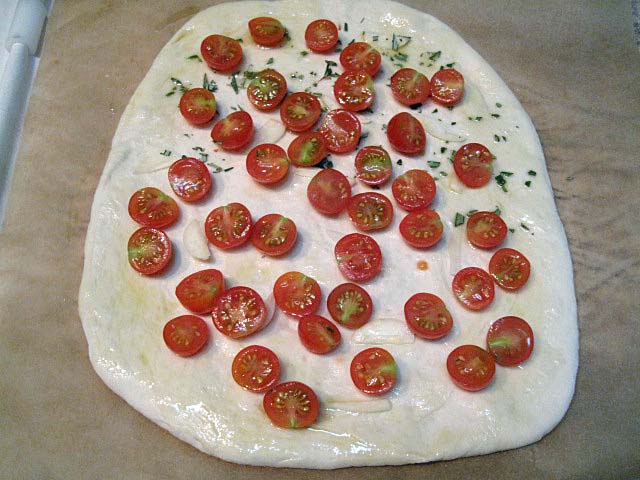
Pizza with Cherry Tomatoes, pre-bake
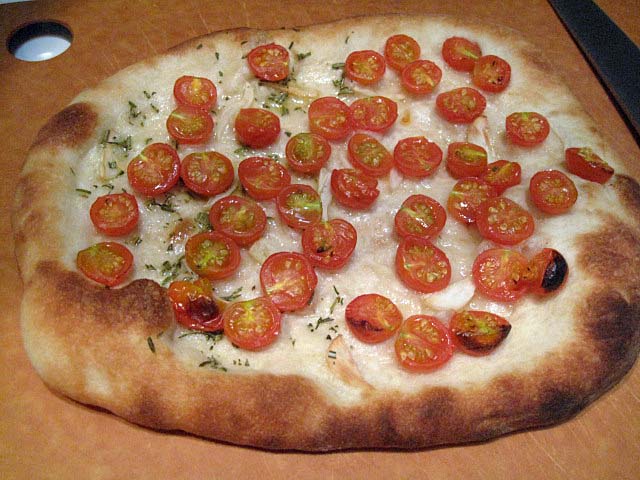
Pizza with Cherry Tomatoes, baked
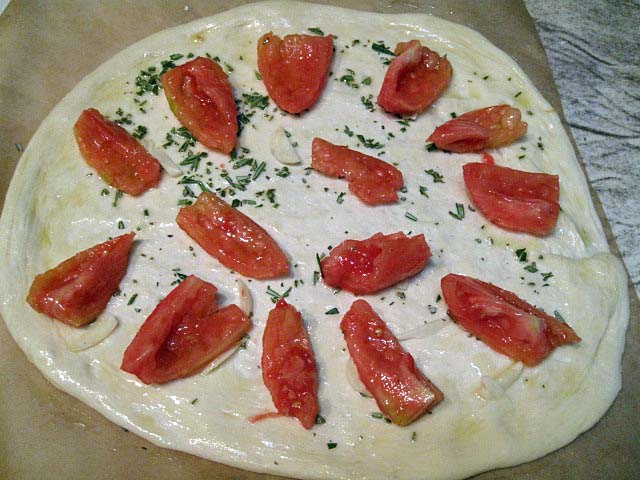
Pizza with Roma Tomatoes, pre-bake
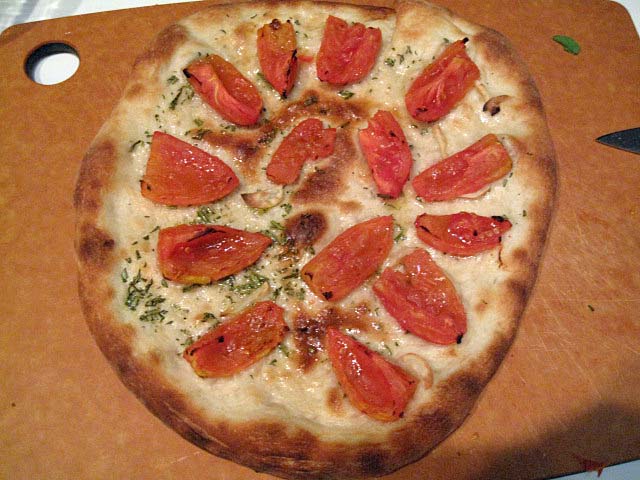
Pizza with Roma Tomatoes, baked
The results were wonderful! The dough stretched easily to paper thin without tearing and baked so crisp there was no sagging when a slice was help up by the corona. Biting into it was a noisy crunch. The flavor of the crust was delicious. The whole experience sold me on minimalist toppings.
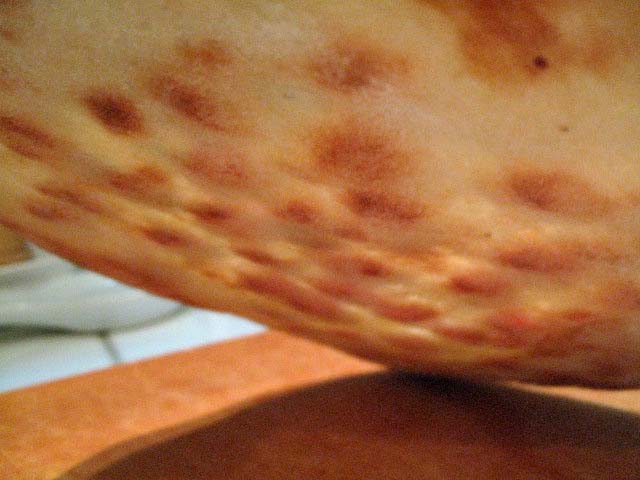
Pizza bottom crust

Thin crust
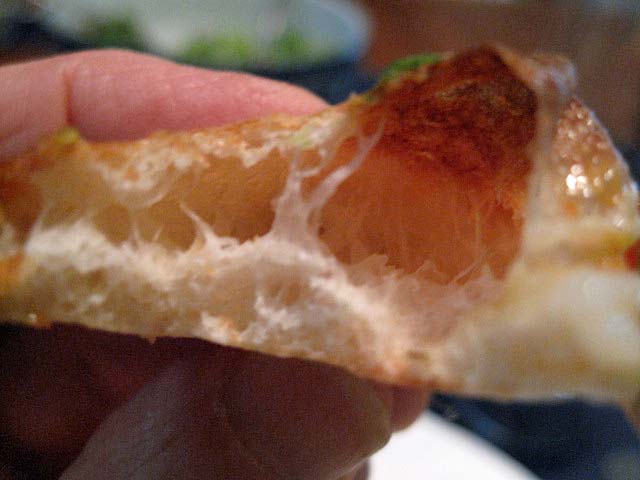
Crust
I don't think adding a few capers, or olives or mushrooms would do any harm, but I don't think making pizzas with heavy saucing, lots of cheese or lots of anything will be tempting again.
The pizza was a nice follow-up to last night's bruschetta.
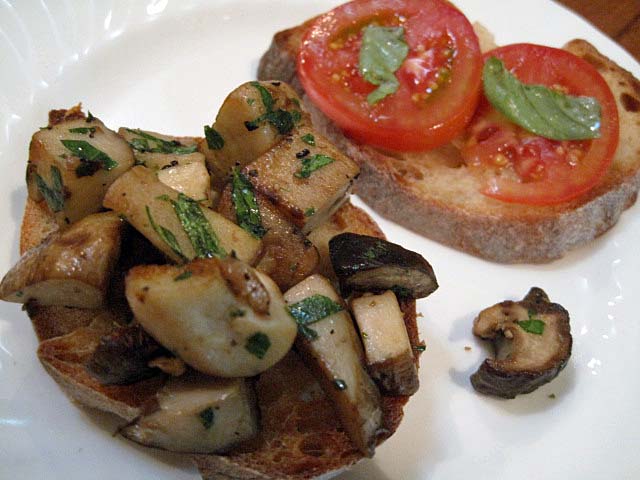
Bruschetta with fresh funghi porcini and with tomatoes and basel
David
Submitted to YeastSpotting
- dmsnyder's Blog
- Log in or register to post comments
Perfect light meal for these warm summer days! Less is more with pizza, no more than 3 toppings is a good rule but, I can't convince my growing grandkids. I call the type of crust you have made a cracker crust..lovely tasting and gives a nice crunch when bitten into. This type of crust is also wondeful made with a mixture of duram and bread flours, when I make it, Mike says it is his favorite.
Happy Fourth of July,
Sylvia
Yes, the crust was like lavash.
When you make pizza crust with durum, do you use fine durum or semolina? What percentage durum/BF?
David
I like to use duram flour at about 5% duram/BF, extra fancy/fine/pasta grind semolina is okay too.
Sylvia
This crust looks great. My Napolitano recipe is more complex... enough so that I rarely bother to use it. This one will be tried this weekend.
Question: In step 5, when you say "Mix the dough at Speed 2 for about 3 minutes." are you refering to a Hobart-style mixer with speeds 1, 2, and 3, or a Kitchenaid-style with speeds 1 through 10. My assumption is "medium speed," say 4 or 5 on a KitchenAid, but a clarification would be nice.
Cheers
Paul
I'm talking about a KitchenAid mixer.
David
nice pies, David, and terrific accompanying photos. My dough is similar to yours, except I use 58% water (the Vera Pizza Napoletana regulations specify 54%-60% water). Here's a recent effort - a meat-lover (pepperoni, sausage, bacon bits). For me, the secret's the flour. I use 10oz/285g of dough for a 14" crust. The Tipo 00 flour creates an unbelievably extensible dough; I could get ever larger if I had a bigger peel and stone, but I'm limited to around that 14".
Stan Ginsberg
www.nybakers.com
My dough had a nice balance of extensibility and elasticity. When I've used Type 00 flour, the dough didn't have much elasticity and tended to tear when stretch as thin as I wanted it. Maybe the lower hydration is the key. What do you think?
Nice pie, there!
David
when I first started making pizza at home, I used Peter Reinhart's BBA formula, which comes out over 70% hydration when you include the oil, and ran into the same tearing problem. The lower hydration really allows the gluten to remain strong. Now the only time I have a tearing problem is when i try to get the bottom crust strudel-thin, i.e., thin enough to read a newspaper through (when I can still find a newspaper)
I'll give Doppio Zero a try with lower hydration.
BTW, my crust was paper thin, except for the corona. It was so thin, I couldn't get my camera to focus on it.
David
David,
Nothing beats a thin-crust pizza, IMO. I was in NY last week and my daughter and son-in-law (both of whom are foodies) took me to a coal-fired pizzeria in Brooklyn (not Totonno's) that was started by a couple of guys from Milan, and you know what? I like my pizza better!!!! They fired theirs at 850, which made me insanely jealous, but the crust was soggy in the middle, and for what they charged for a 16" pie, I felt violated. Sometimes knowledge is a dangerous thing.
Let us know how your next iteration turns out.
Stan
I haven't been to Naples, but I had pizzas in Bologna and Florence a couple months ago with crust that was markedly inferior to mine from yesterday. Now, if I could only get fresh mozzarella di bufala like I had in Italy!
David
My daughter lived in Milan for over a year while she was in grad school, and so she's become my primary pizza critic. her take is that my pizza is equal to or better than the Milanese product, which has a thicker, soggier crust. I've had wood-fired pizza in Rome and Venice (pizza al commune, with San Marzano tomatoes, mozzarella di bufala, and salt-packed anchovies), and I have to say that those pies were sensational, but of course, I adore anchovies.
For the cheese, I can get it at an Italian food distributor in L.A., and I've got to believe that with SF's significant Italian population it shouldn't be too hard to find one in the Bay Area. I realize Fresno is a stretch, but perhaps Glenn can do your footwork. I've also seen it at Costco.
Incidentally, I posted my pizza on the barbie recipe, which includes the dough formula, on the NYB homepage, so feel free to have a look, if you haven't already.
As for my smiling mug, I figured it was long overdue and I finally found a pic that didn't terrify household pets and small children. Thanks for noiticing.
Stan
Stan, your pizza looks delicious. The pie size, my largest pie paddles are also 14". Larger pies can be made, really large ones 36" at a local pizzeria here makes theirs by using a pizza screen. I haven't checked out pizza screens online in while...they do also work nicely for wfo ovens, if the floor is to hot and tends to burn the bottom of the pie.
Sylvia
Stan,
I'm somewhat new to pizza, and had not heard that 54-60 figure for VPN standards. It makes sense to be a little lower than I expected, especially because I've read that 00 flour -- also a VPN standard, right? -- absorbs less water than standard AP or bread flour. I used 62% when I use 00 flour, and despite not having a WFO, I like how it cooks in my oven -- and how it tastes! I'm going to aim a little lower next time and see how that goes.
If you make pizza dough with AP or bread flour, what hydration do you use?
Jonathan
In the never ending search for a good pizza dough this one sounds like the one to try next. Marked in 'Favorites', thank you!
The one I've been using for the last year or so uses a 5-6 hr poolish that I mix with a 60/40 blend of AP and pastry flour, yeast and salt. It's easy to stretch or pin out thinly, and quite lively once it hits the hot stone. My oven only goes to 500F, so not as hot a bake as I'd like but it does the trick eventually.
When we were in Vienna recently we had lunch at an Italian place that did wood-fired pizza in the traditional Naples style or so they said. It was very good, but it wasn't something you could eat entirely without a knife and fork in any gracious fashion. I found the same with the pizza I had in Calgary once. This spot (and I can't recall the name) was in full compliance with the Vera Pizza Napoletana regulations Stan refers to above, to the point they used the same water, flour etc. used in Naples. They had a massive wood fired oven (largest in Canada I believe) and you know, the pie was really good, but I still like a slice I can pick up in my hand without having to roll it up to eat it. Your version of pizza napoletana looks much more my style and what I've always envisioned as being what the classic Naples street food would be like.
Great post David, and thanks for sharing the recipe!
Franko
Obviously, I was extremely pleased with the crust, especially the crispness and lack of flop all the way to the center. And it did have great flavor. I do believe the sparse topping was key. Now I'm curious about a dough made with doppio zero flour and lower hydration, as Stan suggested. But I'm also wondering how yesterday's dough would turn out if lightly sauced and dotted sparingly with mozzarella.
<sigh> So little time, so many breads. At least I don't expect either my wife or I to ever tire of these particular experiments.
David
David,
Glezer's crust is our favorite for the last couple of years, though I do admit to adding a couple of teaspoons of EVOO during the mix. The outside edge rises beautifully, and there's a nice crispiness to it. Your minimalist toppings are appealing...we tend to pile it on. Once the tomatos start coming in this summer, I'm trying your approach. Your photos are lovely.
Sue
What is the crust like when you "pile on" the toppings? Just curious, since this is the first time I've made pizza with this dough.
David
David,
We normally use sauce, bell peppers, green olives, fresh grape or cherry tomatos, sun-dried tomatos, sometimes the small fresh mozzarella balls, and grated mozz. With all that, we have to support the pointy end of a slice between plate and mouth. It does sag under the weight, and isn't crispy in the middle. But the outer third or so of the crust is still firm.
I bake it on a Fibrament stone at 525 (my oven's max) for 5 minutes, then add the grated mozz., and bake for another 5-6 minutes. It's our usual Saturday dinner.
Sue
Hello David,
That crisp crust, and the toppings of tomato, garlic, herbs and greens - all have tremendous appeal!
:^) from breadsong
I just wish I had a WFO for pizzas. Oh well.
There was one little piece of a pizza left over. I'm reheating it on the BBQ. One can pretend. :-)
David
My kind of crust, David! Just the way I like it. And I agree with you on 'the less is more' approach with pizza. My method is similar to yours (long overnight retard in the fridge in oiled bags, except I don't use ziplocs but use less expensive ones which I seal with an elastic band). I also freeze for future use and it works very well. My formula is also almost identical to yours, except that I use a 65% hydration, but I am interested in Stan's comment about 54 - 60% hydration and think I will try that next time. Recently I have been adding sourdough starter to the dough and even going for less yeast and I think the flavour is even better.
Best,
Syd
Converting a pizza dough formula to SD is definitely on my to do list!
I've made pizza in the past with Nury's Light Rye dough and with San Joaquin SD, and both were very tasty. Note that both of these were high-hydration doughs, though.
David
Baking pizza came before bread for me - actually, it was the gateway to SD bread baking, as is the case for many I suspect. I have tried many, many pizza recipes and techniques seeking to get as close as possible to the flavour of the best pizza I have ever tasted, which was a simple marguerita from an ancient woodfired oven near the Trevi Fountain in Rome. Classic thincrust. Waited an hour in a long queue, but boy was it worth it! That experience was 25 years ago now, but it's still vivid in my memory: it turned the light on for me - great pizzas are about the crust primarily. Many toppings can work (as long as they're light and don't overpower the experience of the crust)...but they don't mean a thang if the crust ain't got that zang!
After moving through multiple yeasted pizza recipes, tweaking the best in every way I could conceive of, I came across Varasano's site and that was it: sourdough pizzas are undoubtedly, for me, superior in flavour in a domestic oven context. I should qualify that by adding that I am into traditional thincrust lightly-topped pizzas in unashamed reverence of the one that turned my head around in Rome. The closest I have gotten is the SD recipe I use now, which does have a very light dry yeast spike. I hardly ever compromise in this way, but I've found a couple of pinches of yeast add a little airiness to the crust that I like. I also find that retarding it for 2-3 days in the fridge brings it up to optimal flavour.
I developed my SD pizza after initially basing it on Varasano's formula. He recommends WFOs, of course, but being confined to a domestic and not being prepared to fiddle with it to push the temperatures higher (as Varasano recommends), I began working on tweaking his technique to suit my circumstances and preference for hand-mixing the dough. I just can't improve on the process and formula I use now, although I still try the occasional tweak. From time to time I even revisit yeasted doughs, but my experience is that they just don't come close for flavour. I am well aware that WFOs make an enormous difference, however, having had the privilege of baking in one. Yeasted pizzas can certainly work as well as SD in a WFO environment (my favourite commercial pizza place does fantastic WFO trad thincrust pizzas using a compressed yeast formula), but for domestic ovens it's SD every time for me.
I've posted the link before, but if anyone is interested in having a look at my SD pizza formula and process - or even actually trying it! - you'll find it here.
Best of pizza baking!
Ross
PS: A couple of things I sometimes do that I've found work well for domestic-oven-baked yeasted and sourdough pizzas:
1. Par-baking your olive-oil-spread pizza bases for 2 minutes or so, then remove carefully from oven and put on toppings before returning to oven to complete the bake. Par-baking gives a nice bubbled crust effect.
2. For last 2 minutes of bake, turn on your griller (‘broiler’ is the term in the States, I think). This will give you a char on the edges and raised areas, similar to a wood-fired oven (but not as good, since it doesn't impart the same tantalising smokiness to the flavour).
Here's a crumb shot of one I baked a couple of nights back:
See - no droop! Home-grown 'organic' San Marzano tomatoes on this one. A rare treat in this part of the world in winter. The bubble you see on the right is a result of par-baking the crust. You can see how thin the crust is elsewhere if you track immediately to the left. I selected this slice for the bubble. The slice extends some way to its tip, which is cut off in the pic.
Your pizza slice looks just like what I'd like to achieve consistently.
Re-reading Jeff Verasano's treatise, his target crust is softer and springier than the crisp crust I got.
Lot's of experimenting to do!
Thanks for sharing!
David
Yeah, I reckon his crust is a product of higher temp quick baking, though. And while I hold Varasano in the highest regard - as mentioned, his SD formula was my reference point for my current SD pizza dough - I really like the crisp, thin crusts of the type I get now, as long as the rim is not crisp to the point of brittle. That takes some timing. On the subject of consistency, I don't always get my pizzas exactly right, but have got it down pretty well now...and when it all comes together perfectly it's a joy. Your crust looks excellento, David, BTW - I think we like the same sorts of qualities in a pizza.
Very pleased to share and maybe contribute something back. You've given me so much in your generous posting over the last couple of years, and I know I am far from alone in this!
Cheers (raising a nice glass o red over a thincrist marguerita pizza...virtually speaking, of course, since it's only 1pm here)
Ross
I spent 20 years in the US Navy, and most of my deployments were in the Mediterranean Sea. You wouldn't believe how many times I've been to Naples. Unfortunately, I wasn't aware of the history of pizza back then. Seafood was more important to me back then. Drinking wine was more important.
I love cooking now, and thin crust pizza is my favorite, even though I'm from the Chicago area. I've even figured out how to make crispy crust pizza with lots of ingredients. What I figured out is that less is more. I even use 3 different cheeses on my pies along with fresh mushrooms, onions and multiple peppers.
Hi David!
Pretty pies! I like the fact that the dough looks properly proofed, with a nice browning to the crust as a result of residual sugars.
I have five or six different doughs I use for pizza - depending on my mood. I typically make two and sometimes three different doughs when I fire up my WFO because I like different doughs for different pies/topping combinations/topping weights. I would agree that OO based doughs tend to be better at sub60 hydration, but I am not much of an OO fan. I find it directionally "stale" (bland from being on the shelf too long?) and though its tactile feel is wonderful...I don't find the texture of the baked pie that intriguing or special and, in my experience, OO gets soggy too easily unless you make sure your toppings are really dry. (Using tomato halves and slivers instead of sauce is a wise idea IMO, especially on OO) .
What I find most interesting is using relatively fresh and aromatic organic flour from a (relatively) local mill. Just as I find this flour enhances my breads, I really, really think it steps the pizza dough up another notch. I use 10.5 % protein AP for my straight "Neopolitan" style dough at 62 to 70 percent (depending on my mood). I personally prefer to have some oil in my BF based doughs - which I think helps their "bite" and gives them better resistance to soggy toppings. My BF is only about 13 percent and I typically do it at 66 to 74 percent. Both are basically hydration adjusted Reinhart's Neopolitan and Neo-Neopolitan doughs with overnight retard which I think is beneficial. Other doughs I do reasonably often include sourdough and a lightly sweetended dough for bigger groups where we are doing lots of dessert pizzas. Occasionally I add a little rye, whole wheat, or semolina (usually at 5 percent or so of total flour) but...not often. I really like my base doughs!
Thanks for sharing!
Jay
I'm intrigued by your selection of doughs according to the topping. Can you share some specifics? I'm interested in your thought process as well as formula examples.
Thanks.
David
Being a pretty serious breadhead for ten years and acquiring a WFO about six years ago combined to push me in a somewhat personal approach to pizza. I tend to view bread as a continuum with pizza as just one rendition - much as we all make very different breads using nothing but flour, water, salt, and yeast (whether including other minor flours or not). As a result, my varying my doughs is mostly whim - much as I suspect your decision of what bread to make today. As an aside my breadmaking is totally dominated by my standard 1.5 pound boule. I dabble in other breads. My pizza dough is much more variable, reflecting mainly the pies I plan to make.
A couple of pie comments...I usually plan 4 to 6 different pies for an evening, almost always beginning with a Margherita. Depending on the guests and my mood I MAY do a proper VPN pie using OO flour or my AP Neopolian dough. I make my VPN Margherita pie using sauce which I cook down to make it thick to reduce the impact of the water in the sauce on the dough. For my AP dough I usually use sauce but also use halved cherry or grape tomatoes (most common) or thin wedges (wet seeds removed)(sometimes - when I have homegrown heriloom tomatoes). I have a real aversion to soggy dough and that drives my dough selection for specific pies - and how I apply/use toppings.
If my sauce is wet I will often brush EVOO on the dough before laying down the sauce to help reduce sogging of OO and my AP Neopolitan dough. My other approach for non Margherita pizzas when the pie uses prosciutto or similar materials is to use the meat to partially serve as a barrier to the wet toppings. I prefer to make pies on these doughs that are relatively sparse and dry (no wet ingredients). I like these doughs for their mouth feel. They can be crisp and hold form under the right conditions and yet have a soft, tender cornicione. I probably don't make these pies quite as thin as some of you. (I don't usually aspire to a superthin, crackerlike Roman crust.) Among the pies I prefer to make on these doughs are Quattro formaggio (nothing but cheese - Reinhart's recipe in American Pie is a good starting point); Caramalized onions, Blue Cheese, and Walnuts (from American Pie - very sparse); Nutella, Mascarpone, Banana, Brown Sugar, and Pecans; and other really sparse pies.
My wife persists in wanting a more "American" style pie along the lines of a conventional Italian sausage, Tomato Sauce, and Mozz. Even made a bit sparse, the moisture of the sauce and the weight of the toppings will simply overwhelm Neopolitan style doughs and they will droop and even with oil get soggy. It can also be hard to get the dough to really set under all that weight - even using oil to try to protect the dough. This is where the Neo-Neopolitan style dough (again Reinhart as a starting point) is handy. The higher protein yields a tougher cornicione (especially when oil is omitted as in a Neopolitan style dough) but it also provides more strength to support the toppings and the oil helps the dough resist moisture and getting soggy. A Neo-Neopolitan dough (which includes oil and sugar or honey or Agave syrup) is especially robust when brushed with oil to aid further in resisting moisture. This is my go to dough for my wife, kids, teenagers, large groups and heavier pies because it is more forgiving and I can knock the pies out faster without having to be as careful as with the Neopolitan.
I acknowledge the appeal of sourdough pizza dough. It has a place and for many on TFL it is likely to be the preferred dough. For some reason it doesn't send me. Weird because almost all the bread I bake is sourdough but??? I just make about a 64% hydration AP Neopolitan or a 67% BF Neo-Neo (with oil and sweetener) dough and use it in the place of the corresponding dough above.
I typically use 5% freshly milled whole wheat in my sourdough bread and that practice leads me to sometimes put fresh milled whole wheat in my pies. As an aside, my fresh local flour has a similar aromatic quality to the impact of adding the freshly milled wheat so I am not doing that as much with this flour. I have not tried stone ground whitewhole wheat - which I have - and intend to try soon. Should be good - nutritionally if nothing else. When I add whole wheat I use the dough according to the above guidelines.
I tend to use semolina for pasta. It is fine in pizza dough. I just haven't gotten hooked. It does have a mouthfeel/flavor impact but I tend to prefer my "other" doughs. Reinhart's Roman dough is basically an AP Neopolitan dough with a bit of semolina. It tends to be crunchier but it is still vulnerable to sogginess in my experience. It is definitely worth trying and might be what you are looking for. I do it occasionally as a diversion. I like it with really sparse toppings. As in bread I prefer Durum flour to the coarser "Semolina" more commonly available.
Working on the Jewish baking book last summer got me into using rye more and I sometimes add rye at 5% with a slight decrease in hydration. I am more likely to use this dough with odd toppings and toppings with stronger flavors such as pastrami, salumi, etc. I probably have a tendency to use rye in a modified Neo-Neo where the oil can help protect it.
WRT mixing dough, I mix all my doughs by hand and retard overnight. I ball my non-sourdough doughs using BF and oil after finishing kneading. I retard my Neopolitan. OO and AP based doughs and BF sourdoughs in bulk. All doughs are removed from the refrigerator two hours before anticipated use (well within a half hour or so) and the bulk retarded doughs are balled upon being removed from the refrigerator. WHY? Because I find late balling of OO and BF doughs results in a tougher texture that does not appeal to me. They are also more difficult to handle when late balled. All of my doughs tend to be rather wet to give a really open cornicione which I like.
Hope that makes sense and is useful!
Good Luck!
Jay
Lots of information!
Let's see if I understand: To achieve a dough for pizzas with heavier topping that won't get soggy, you use higher protein flour. You add oil and sugar to the dough. You retard it in bulk rather than in balls. You brush the dough with EVOO before other toppings.
Did I get it right? Did I miss anything important?
David
For heavier toppings I want higher protein. But to me higher protein can get tough so I like to add a bit of oil also (about 2 T per 500 gms flour) which also helps the dough resist getting soggy. The sugar is IMO optional. I think it helps the yeast a little and gives a marginally airier dough but I definitely consider it optional. I don't brush all dough with oil - for example I wouldn't put oil on the dough before making your Pizza Margherita for it is dry and doesn't need the help. For oil I use both straight EVOO and EVOO doctored with spices (commonly referred to in pizza books as spicy oil.)
I retard bread flour doughs and OO Italian flour in balls. AP doughs in bulk.
That's about it!
Jay
Depending on what's going on the pizza and how much, I may brush my crust with EVOO right before dressing, rather than adding oil to the dough, which IMO softens the crumb a bit (I prefer my crust on the chewier side). I find that light layer of oil does a nice job of sealing the dough against the sauce.
Stan
www.nybakers.com
I agree that that layer of EVOO seals the dough surface. I reckon it enhances the overall flavour, too. I also like to sprinkle some dried oregano over the olive oil-smeared crust at that stage. Sets up a nice subtle herby undertone.
I use oil on the dough more as a sealant (which, as I explained is related to toppings) rather than for flavor. IF I want oil for flavor I usually apply it after I bake the pie. While I sometimes apply herbs directly I tend to put them in the oil.
But to each his own! That's the beauty of it! Whatever works for you and makes you happy!
Jay
I've done the EVOO thing, but I always wondered why some people dock the dough before dressing it. Does it do anything beneficial?
Docking is typically done to pinch the top and bottom of the dough together in order to prevent formation of large bubbles. It can be very helpful when making flatbread or super sparse pizzas, whether indoors or on a WFO. In my experience the toppings will almost always be heavy enough to prevent large bubbles except where the dough is exposed - as at the cornicione. I have had more trouble with docked high hydration doughs sticking to the peel where the docking tines are than with big bubbles so I don't do it for thin crust WFO pies. My pies aren't very thick so I would defer to others for comments on thicker crusts and indoor ovens.
Hi Stan!
I fully agree. I want oil in my BF doughs specifically to soften the crumb. It has the benefit of making the dough a bit more resisteant to wet toppings but... coating with oil provides more protection.
Good to hear from you!
Jay
Jay, I'm a complete amateur when it comes to all this stuff, but everything in your post is stuff I've read in books, but don't take that the wrong way. References to things like durum flour make it seem like I'm on the right track. I bought a sack of Durum Atta flour from a local Indian grocery and use it for various purposes, but mostly for dusting my peel and rolling out my pizza pies when I want an extra thin crust. It makes me snicker when I hear the snobs criticize people that use a rolling pin for pizza. Don't they know that some of the most famous pie houses in Italy roll out those things over and over again to get that famous Roman crust?
When it comes to mixing dough, I'm a Van Over fan. My dough is proofing a couple minutes after I get done weighing everything. The two most important things in the process are a good scale and an instant read thermometer.
I also retard my doughs overnight in the fridge. I also freeze some of it because I live alone and can't possibly eat that much pizza in a couple days, no matter how much I love it.
Regards,
Billybob
Hi Billybob!
I don't think there are any big secrets... The biggest secret to me (for pizza or bread) is having a strong opinion of what you want that so that you can find a formula/process that gives you the characteristics you want. My focus is very specifically on the characteristics of the finished pie/crust and that leads me to use different doughs for different pies. I strongly prefer retarded dough over "today". But that is only me and the perspective is simply mine. Perusal of this site will reveal people who are devoted to a single dough: based on OO, sourdough, or ??? whatever.
If I sound like a book it is probably Peter Reinhart speaking for I am heavily influenced by him for American Pie came out as I was preparing to build my oven, I took a class from him about the same time, and I consider him a friend. The recipes I use are very similar to the ones in that book, primarily in higher hydration. While many pizza books offer a variety of dough formulas, offhand I am not aware of any that are very vocal about matching dough to toppings. (No doubt I am overlooking something!). Altogether I don't think my approach is particularly revolutionary but it isn't "mainline" in my experience either. To me pizza is about, and begins with, great dough. The toppings should IMO never be more than a costar and more usually in a supporting role.
I use coarse semolina exclusively for dusting the peel and for testing hearth temp (okay I use my IR thermometer occasionally but semolina is easier (toss on oven and count: 1001, 1002, 1003 and the semolina should turn black about the three, if much faster, the hearth is too hot and if much longer the hearth is too cold).
While I am currently "all hand work" with dough I also find the rolling pin aversion humorous. I have rolled my dough as an experiment and I can get a cornicione that is very similar to a hand made pie (assuming the pie is properly proofeds - won't work as well when overproofed!). I am not crazy about freezing but...dough only forozen a week or so can be amazingly close to fresh in effect. Certainly not a disaster to freeze dough!
Thanks!
Jay
Flour was Tipo 00 Pivetti Pizzeria at 58% hydration, 2% salt, 0.2% instant yeast.
No fermentation, retarded 24 hours.
Proofed 1 hour and stretched to a nice thin crust.
Dressing (in this order) was:
EVOO/Minced garlic
Cheese (blend of mozz/asiago/provolone/parmesan/roman)
Sauteed spinach
Bacon bits
Sliced mushrooms
Baked covered at max temp (around 550F/280C for 5-6 minutes.
And here's the crust:
Stan Ginsberg
www.nybakers.com
It would look even better if I weren't full of homemade pasta with ragu and hadn't just finished sampling the just-cooled sour rye made with flours from that nybakers.com outfit. (More about that later.)
David
enough said